Quand vous skiez vite et agressivement, les bons skis peuvent faire toute la différence dans votre expérience. Il ne s'agit pas seulement de vitesse - c'est une question de contrôle, de précision, et d'avoir un équipement qui correspond à votre style. Les skis courts, comme les Snowfeet Skiblades, changent la donne pour les skieurs qui excellent dans les virages serrés, les terrains techniques et les réactions rapides. Voici pourquoi :
- Skis courts = meilleur contrôle. Ils sont agiles, facilitant les virages serrés et les manœuvres rapides.
- Réponse plus rapide. Les skis courts s'adaptent instantanément aux changements de vitesse, vous offrant un meilleur contrôle sur des pentes imprévisibles.
- Léger et compact. Facile à transporter, à ranger, et moins fatigant lors des longues journées.
Snowfeet propose trois modèles : 65 cm pour les figures freestyle, 99 cm pour la performance polyvalente, et 120 cm pour la vitesse et la stabilité. Que vous carviez entre les bosses ou dévaliez des pentes raides, les skis courts vous aident à garder le contrôle et à profiter de la descente. Prêt à améliorer votre niveau de ski ? Plongeons dans les détails.
Skis courts vs. skis longs
Pourquoi les skis courts fonctionnent mieux pour le ski agressif
Quand il s'agit de ski agressif, les skis courts apportent un tout nouveau niveau de performance sur les pistes. Alors que les marques de ski traditionnelles comme Rossignol, Atomic et Head se sont longtemps concentrées sur des designs plus longs, les skis courts - comme les Snowfeet* Skiblades et les Skiskates - changent notre façon de penser le ski rapide et dynamique.
Les skis courts sont synonymes de vitesse, de contrôle et de réactions rapides. Ils vous permettent de bouger avec précision, en suivant les décisions prises en une fraction de seconde sur un terrain difficile. Décomposons comment ces skis offrent un meilleur contrôle, des temps de réponse plus rapides et une commodité accrue.
Meilleur contrôle et virages rapides
Les skis courts brillent dans les terrains étroits et techniques où chaque mouvement compte. Que vous zigzagiez entre les bosses, évitiez les arbres ou carviez sur des pentes raides, leur conception rend les virages serrés et précis sans effort.
"Les skis courts sont plus faciles à carver et à tourner que les skis longs, car vous n'avez pas besoin de mettre trop de pression sur vos genoux pour incliner réellement les skis sur la carre." - Équipe Snowfeet
Les Snowfeet* Skiblades, disponibles en tailles comme 65 cm, 99 cm et 120 cm, sont conçus avec ce type d'agilité en tête. Comparez cela aux skis traditionnels de marques comme Elan ou Head, qui mesurent généralement entre 150 cm et plus de 200 cm. Ces skis plus longs demandent plus de force pour manœuvrer, ce qui entraîne une fatigue plus rapide lors de descentes longues et intenses. Les skis courts, en revanche, facilitent les virages et vous aident à garder votre énergie toute la journée.
Réponse plus rapide et contrôle de la vitesse
Lorsque vous skiez de manière agressive, vous devez ajuster votre vitesse rapidement et en toute confiance. Les short skis facilitent cela. Ils accélèrent et décélèrent en un éclair, vous offrant un contrôle précis de votre vitesse. C'est particulièrement utile dans les virages serrés et les sections techniques de la montagne.
Voici la différence clé : les skis longs avec un grand rayon de courbe sont stables à haute vitesse mais manquent d'agilité pour des changements de direction rapides. Les short skis, avec leur rayon de courbe plus petit, sont beaucoup plus réactifs et faciles à tourner. Par exemple, les Skiskates - mesurant seulement 44 cm - sont l'ultime en agilité. Leur bord court permet des transitions rapides entre les virages, vous gardant en contrôle même dans des conditions imprévisibles.
Faciles à transporter et à ranger
Au-delà de la performance, les short skis offrent des avantages pratiques qui les rendent très faciles à manipuler. Les skis traditionnels, souvent longs de plus de 150 cm, peuvent être difficiles à transporter et à stocker, surtout si vous changez de station ou disposez de peu d'espace.
Les short skis, grâce à leur taille compacte et leur poids léger, sont beaucoup plus faciles à gérer. Les Skiblades Snowfeet*, allant de 65 à 120 cm, se rangent facilement dans les voitures, sont simples à porter dans les lodges bondés, et peuvent même être stockés dans de petits appartements.
Après une longue journée sur les pistes, la légèreté des short skis signifie que vous n'êtes pas coincé à transporter un équipement lourd. Vous pouvez ainsi économiser votre énergie pour skier - et vous concentrer sur l'amélioration de votre technique plutôt que de lutter avec un matériel volumineux.
"Les short skis offrent plus de plaisir et de liberté de mouvement, ils sont ludiques, réactifs, légers aux pieds, plus faciles à arrêter et plus simples à manier comparés aux skis longs encombrants." - Équipe Snowfeet
Snowfeet* Short Skis : Le meilleur choix pour les skieurs agressifs
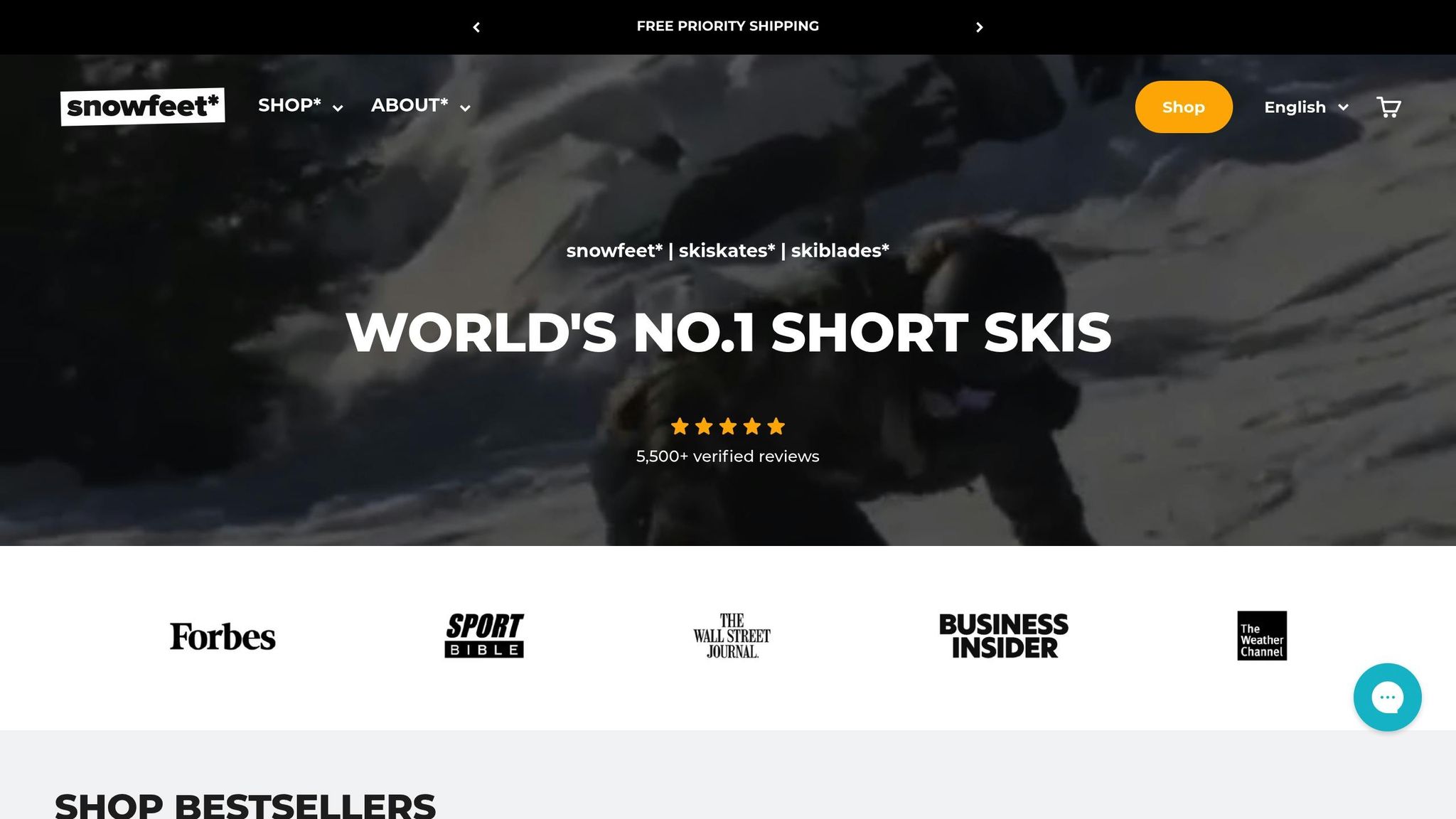
Si vous aimez le ski agressif, vous savez à quel point il est important d'avoir un équipement qui suit vos mouvements. C'est là que les short skis Snowfeet* brillent. Contrairement aux skis longs que la plupart des marques privilégient, Snowfeet* a renversé la tendance avec des designs courts et vifs, axés sur la vitesse et la précision. Ces skis sont conçus pour les skieurs qui exigent des réactions rapides et adorent les descentes dynamiques.
Options de produits Snowfeet*
Snowfeet* propose trois modèles de Skiblades, chacun conçu pour correspondre à différentes préférences de ski et niveaux de compétence. Voici la gamme :
- Modèle 65 cm : Parfait pour les amateurs de freestyle qui ont besoin d'une agilité maximale. Ces skis sont excellents pour réaliser des figures rapides et naviguer dans des espaces étroits.
- Modèle 99 cm : Un compromis solide qui allie agilité et stabilité. Idéal pour ceux qui veulent un peu plus de contrôle sans sacrifier les virages rapides.
- 120 cm Short Skis : Le choix incontournable pour les skieurs en quête de vitesse et de stabilité. Ils conservent la maniabilité des short skis tout en offrant plus de soutien sur les pistes larges.
Jeff Knight, un skieur expérimenté, l'a parfaitement résumé :
"Ce que j'adore avec ces skis, c'est que je peux tourner sur un dix centimes. Incroyable comme il est facile et rapide de tourner."
Il a également partagé quelques conseils pour choisir le bon modèle :
"Je trouve les 65 très peu indulgents si je fais une erreur d'équilibre... Si vous avez un bon équilibre, ces skis sont excellents, surtout si vous aimez les 'tricks'. Si vous êtes comme moi et que votre équilibre vous échappe, des skis plus longs peuvent être un meilleur choix. J'ai essayé les 99 de mon pote, et ils étaient parfaits pour moi."
Passons maintenant à la comparaison entre Snowfeet* et les marques de ski traditionnelles.
Snowfeet* vs marques de ski traditionnelles
Quand on compare Snowfeet* aux grandes marques comme Elan, Head et Atomic, la différence est claire. La plupart des skis traditionnels mesurent entre 150 cm et plus de 200 cm. Bien que ces skis plus longs soient excellents pour la stabilité à grande vitesse, ils n'offrent pas la sensation rapide et réactive que recherchent les skieurs agressifs. Snowfeet* se concentre sur les styles de ski modernes, vous offrant l'agilité et le contrôle nécessaires pour les virages serrés, les bosses et les snowparks.
Prenez Jakub F de Prague, par exemple. En mars 2025, ce snowboardeur de toujours a découvert les Skiblades Snowfeet* et a constaté qu'ils ont complètement changé son temps en montagne. Il pouvait apprendre à ses enfants à skier tout en portant ses boots de snowboard fidèles. Jakub a partagé :
"Avec ces petits skis, on se sent beaucoup plus agile, plus rapide, et surtout – à l'aise... Snowfeet* a transformé mon ski – assez agile pour suivre la cadence de la famille et des amis."
Les marques de ski traditionnelles privilégient souvent la stabilité à haute vitesse, mais cela se fait au détriment de la maniabilité. Snowfeet* adopte un design réactif qui rend le ski naturel, même sur un terrain difficile.
Principaux avantages des produits Snowfeet*
Snowfeet* se démarque car il est conçu pour les skieurs du monde réel. Contrairement aux skis traditionnels qui vous enferment dans des chaussures de ski spécialisées, les produits Snowfeet* fonctionnent avec des chaussures d'hiver ordinaires, des boots de snowboard ou des chaussures de ski. Cela signifie moins de tracas et une courbe d'apprentissage plus rapide, pour que vous puissiez vous concentrer sur votre technique plutôt que sur votre équipement.
Un autre grand avantage ? Leur conception légère. Les skis courts Snowfeet* sont plus doux pour vos genoux, ce qui en fait un excellent choix pour les skieurs ayant des problèmes articulaires. Un utilisateur a même déclaré :
"Beaucoup plus facile de gérer les bosses l'après-midi et plus doux pour mes genoux."
Le poids plus léger signifie aussi moins de fatigue, vous permettant de dévaler les pistes du matin au soir. Avec plus de 5 500 avis vérifiés à leur actif, Snowfeet* a prouvé qu'ils peuvent gérer tous les styles et conditions de ski.
Avec tous ces avantages, l'étape suivante est de déterminer quel modèle Snowfeet* correspond le mieux à votre style de ski.
sbb-itb-17ade95
Comment choisir le bon modèle Snowfeet*
Choisir le bon modèle Snowfeet* peut faire toute la différence dans votre expérience de ski. Snowfeet* propose trois modèles - 65 cm, 99 cm et 120 cm - chacun conçu pour répondre à différents niveaux de compétence et préférences de terrain. L'astuce ? Associez vos capacités et votre style au bon modèle pour profiter au maximum de votre temps sur les pistes.
Choisir selon le Niveau de Compétence
Votre niveau de compétence est un excellent point de départ pour décider quel modèle Snowfeet* choisir. Si vous débutez en ski, le modèle 65 cm est un choix solide. Sa flexibilité plus souple le rend plus indulgent, aidant les débutants à gagner en confiance sur la neige.
Les skieurs intermédiaires se tournent souvent vers le modèle 99 cm. Il est plus rigide que la version 65 cm, ce qui signifie qu'il gère mieux les hautes vitesses. De plus, il offre toujours la capacité de virage rapide pour laquelle Snowfeet* est reconnu.
Pour les skieurs avancés, les Short Skis de 120 cm sont le choix numéro un. Ils sont conçus pour la puissance, avec une rigidité accrue qui améliore le contact des carres et la stabilité. Ce modèle performe aussi bien en poudreuse, ce qui le rend idéal pour des descentes rapides et agressives sur un terrain difficile.
Bien sûr, l'endroit où vous skiez compte aussi. Adapter votre modèle au terrain est tout aussi important.
Choisir le Bon Modèle pour Votre Terrain
Différents terrains exigent différents modèles Snowfeet*. Si vous restez sur pistes damées, les modèles 99 cm et 120 cm sont vos meilleurs alliés - ils offrent un excellent contrôle des carres. Mais si vous affrontez des bosses ou slalomez entre des passages étroits, le modèle 65 cm brille.
Pour les snowparks ou les terrains aménagés, les Skiblades plus longs (90–120 cm) sont un choix judicieux. Ils offrent la stabilité nécessaire pour des atterrissages sûrs lors des sauts tout en restant assez agiles pour des ajustements rapides.
Ski en poudreuse ? Les skiboards de 120 cm sont votre choix idéal. Ils offrent suffisamment de portance pour vous faire glisser en douceur sans vous alourdir. Snowfeet* travaille aussi sur des skiboards poudre de 99 cm avec une forme plus large, spécialement conçus pour les aventures hors-piste. Gardez simplement à l'esprit que les skis courts ne sont pas idéaux pour les pentes extrêmement raides ou la poudreuse profonde.
Parlons maintenant de la façon dont votre style de ski influence votre choix.
Adapter à Votre Style de Ski
Votre style de ski est un autre facteur clé pour choisir le bon modèle. Si vous êtes axé sur la vitesse, optez pour les modèles 99 cm ou 120 cm. Leur stabilité à haute vitesse les rend parfaits pour les descentes rapides.
Si vous aimez les figures, les sauts et les virages serrés, les Skiblades de 65 cm sont faits pour vous. Ils sont super agiles et donnent une sensation très proche des skates sur neige, ce qui ouvre des possibilités créatives pour le ski freestyle. Leur taille compacte les rend aussi plus faciles à contrôler lors des manœuvres aériennes, vous permettant de réaliser des sauts et des rotations que les skis plus longs ne peuvent pas gérer.
Pour une expérience tout-terrain, le modèle 99 cm trouve le parfait équilibre. Il est assez polyvalent pour gérer des conditions de neige variées et un terrain escarpé tout en offrant la performance de virage rapide pour laquelle Snowfeet* est célèbre.
Enfin, tous les modèles Snowfeet* présentent une largeur étroite (moins de 85 mm), ce qui les rend idéaux pour carver sur pistes damées. Cela les distingue des skis plus larges (plus de 95 mm), mieux adaptés à la poudreuse.
Tirer le meilleur parti de vos Snowfeet* courts
Les Snowfeet* courts révolutionnent les pistes, mais pour obtenir les meilleurs résultats, vous voudrez peaufiner votre configuration et ajuster votre technique. Ces skis sont plus indulgents que les skis longs traditionnels, mais avec quelques ajustements, vous pouvez tirer pleinement parti de leur design unique.
Conseils d'installation et d'entretien
Bien régler vos fixations est essentiel. Ajustez-les en utilisant les réglages DIN correspondant à votre poids, taille, âge, longueur de semelle de la chaussure et style de ski. Des tableaux standardisés peuvent vous aider à déterminer cela, et testez toujours le déclenchement après ajustement – c’est une petite étape qui fait une grande différence en matière de sécurité.
Gardez vos Snowfeet* en parfait état avec un entretien régulier. Appliquez de la cire sur les semelles pour les garder rapides et lisses, et aiguisez les arêtes pour un meilleur contrôle. Après chaque session, séchez les arêtes pour éviter la rouille. Si vous voulez aller plus loin, appliquez une fine couche d'huile pour une protection supplémentaire. Les fixations réglables conviennent à la plupart des tailles de chaussures US (6–13) et peuvent être facilement ajustées à la maison.
Une fois votre équipement prêt, il est temps de se concentrer sur la technique.
Adapter votre technique de ski
Les Snowfeet* courts répondent rapidement, vous devrez donc peut-être ajuster votre approche, surtout si vous êtes habitué aux skis traditionnels. L'un des plus grands ajustements est d'apprendre à s'arrêter. Au lieu de compter sur des freins, vous utiliserez les arêtes de vos skis. Comme le dit le skieur professionnel Brinaboosk8s :
"Les Snowfeet traduisent surtout le carving rapide en descente sur des lames/quads. Il y a une courbe d'apprentissage à cause de l'absence de freins et du fait qu'il faut vraiment utiliser les arêtes pour s'arrêter, mais c'est très similaire."
L'équilibre est un autre facteur clé. Ces skis sont tellement réactifs que centrer votre poids devient crucial. Comme l'a partagé un utilisateur :
"Mes deux premières descentes avec mes Black Pearls... J'ai remarqué qu'ils voulaient VRAIMENT que je sois centré sur le ski... Ils sont si légers que toute erreur de pilotage est facile à corriger, mais ils vous rappellent de vous centrer. Plus vous les poussez, plus c'est amusant !"
Pour améliorer la stabilité, écartez un peu votre position. Des transitions d'arêtes fluides vous aideront à profiter pleinement de la réactivité rapide des skis. Si vous débutez, restez sur des pistes faciles jusqu'à ce que vous soyez à l'aise, puis progressez vers des terrains plus difficiles.
Passer des skis longs ou du snowboard
Si vous venez des skis longs traditionnels, attendez-vous à ce que tout semble plus rapide et moins exigeant physiquement. Les techniques que vous connaissez déjà s'appliqueront toujours, mais vous devrez vous adapter au rythme plus rapide. Les snowboardeurs trouvent souvent la transition encore plus facile puisque le mouvement de carving est déjà naturel pour eux.
Pour une expérience optimale, pensez à associer vos Snowfeet* à des chaussures de snowboard, surtout si vous avez de petits pieds. Les chaussures de snowboard offrent un excellent maintien de la cheville et fonctionnent généralement mieux avec les fixations réglables que les chaussures de ski classiques. Des chaussures imperméables avec un bon maintien de la cheville sont aussi une alternative solide si vous souhaitez quelque chose de plus léger et flexible.
Faites confiance à l'agilité de Snowfeet* pour des virages nets et précis. Au début, vous pourriez avoir l'impression d'avoir besoin de plus de ski sous les pieds, mais ne luttez pas contre l'équipement. Adoptez la réactivité, et vous vous retrouverez bientôt à glisser sans effort sur les pistes, vous demandant pourquoi vous êtes resté avec des skis plus lourds et plus longs.
Pourquoi Snowfeet* est le meilleur choix pour le ski agressif
Quand il s'agit de ski agressif, Snowfeet* change la donne. Contrairement aux marques traditionnelles comme Rossignol, Atomic et Head, qui misent sur des skis plus longs et plus lourds, Snowfeet* adopte une approche audacieuse avec son design compact, offrant des performances difficiles à égaler.
Avec plus de 5 500 avis vérifiés à leur actif, Snowfeet* prouve que les skis plus courts peuvent offrir une puissance sérieuse pour le ski agressif. Leur gamme - allant des Skiblades de 65 cm aux modèles de 99 cm et même aux ultra-compacts Skiskates de 44 cm - offre une sensation ludique, réactive et un contrôle sans effort. Cette agilité ne brille pas seulement sur les pistes damées ; elle s'adapte facilement à toutes sortes de conditions de ski.
Polyvalence pour tous les terrains
Alors que des marques comme Elan et Head adaptent souvent leurs skis à des conditions spécifiques, Snowfeet* excelle dans presque tous les environnements. Que vous tailliez des virages sur des pistes damées, affrontiez la poudreuse, fréquentiez les snowparks, slalomiez entre les bosses ou exploriez le hors-piste, ces skis compacts gèrent tout. Pas besoin de transporter plusieurs paires de skis - Snowfeet* simplifie et rend tout polyvalent.
Et parlons de la fatigue. Les longues journées en montagne peuvent être épuisantes, mais le design léger de Snowfeet* fait toute la différence. L'ingénierie européenne et la fabrication de précision prouvent qu'il n'est pas nécessaire d'avoir des skis plus longs pour performer à un haut niveau. Comme le dit Jakub F. :
"Avec ces petits skis, on se sent beaucoup plus agile, plus rapide, et surtout – à l'aise. Pas de boucles, pas de bottes lourdes – il suffit de les attacher et c'est parti."
Adorés autant par les skieurs que par les snowboardeurs
Snowfeet* ne séduit pas seulement les skieurs - les snowboardeurs les adorent aussi. Ally d'Indy, une snowboardeuse qui a essayé Snowfeet*, a partagé :
"Je suis snowboardeur et je n'étais pas sûr de ces skis, mais j'ai décidé de les essayer car mon premier amour est le roller. Ils sont géniaux ! Je suis resté sur le bunny à Keystone et je me suis rapidement senti à l'aise avec eux."
Les retours parlent d'eux-mêmes. Andrew B. a déclaré : "Je ne reviendrai jamais aux skis originaux." Nathan F. les a qualifiés de "Meilleur plaisir que j'ai jamais eu sur la neige", et Vanessa du Royaume-Uni les a encensés comme "facilement l'un des meilleurs achats que j'ai jamais faits à ce jour".
Snowfeet* offre vitesse, contrôle et agilité comme aucun autre, redéfinissant ce qui est possible pour le ski agressif. Alors que le matériel traditionnel propose de petites améliorations ici et là, Snowfeet* apporte une approche fraîche et dynamique, spécialement conçue pour les skieurs d'aujourd'hui.
FAQs
Comment les Snowfeet short skis se comportent-ils par rapport aux skis longs traditionnels ?
Les Snowfeet short skis sont synonymes d'agilité et de contrôle. Grâce à leur taille compacte, ils facilitent les virages rapides et précis, même sur un terrain difficile ou dans des espaces restreints. Si vous cherchez une expérience de ski énergique et adaptable, ce matériel pourrait bien devenir votre nouveau favori.
Maintenant, les skis longs traditionnels - comme ceux des marques Rossignol ou Atomic - sont excellents pour la stabilité et la vitesse. Mais les Snowfeet short skis apportent quelque chose de différent. Ils sont légers, faciles à transporter, et bien plus abordables. Parfaits pour les skieurs qui veulent aller vite et s'amuser sans les tracas (ni le coût) des options plus encombrantes.
Quelles sont les différences entre les modèles Snowfeet 65 cm, 99 cm et 120 cm, et comment choisir le meilleur pour mon style de ski ?
La principale différence entre les modèles Snowfeet est leur longueur, ce qui influence leur agilité, stabilité et adaptabilité aux différents terrains selon les niveaux.
- Modèle 65 cm : Idéal pour les débutants ou ceux qui aiment les virages rapides et précis sur pistes damées ou douces. Il est léger, facile à manier, et un excellent choix pour gagner en confiance sur la neige.
- Modèle 99 cm : Un choix solide pour les skieurs intermédiaires. Ce modèle trouve un bon équilibre entre agilité et stabilité, idéal pour les terrains variés et pour perfectionner vos compétences.
- Modèle 120 cm : Conçu pour les skieurs avancés. Il offre un contrôle maximal à haute vitesse et performe magnifiquement sur les pentes raides et la poudreuse - parfait pour ceux qui skient avec un style agressif et rapide.
Lorsque vous choisissez vos Snowfeet, pensez à votre niveau, au type de terrain que vous aimez et à ce que vous souhaitez accomplir sur les pistes. Les débutants se sentiront à l'aise avec le modèle 65 cm, les intermédiaires apprécieront la polyvalence du 99 cm, et les skieurs avancés en quête de vitesse et de précision devraient opter pour le 120 cm.
Puis-je utiliser les Snowfeet short skis avec des chaussures d'hiver classiques ou des chaussures de snowboard, et quels en sont les avantages ?
Oui, vous pouvez utiliser les Snowfeet short skis avec des chaussures d'hiver classiques ou des chaussures de snowboard. Ils sont conçus pour être polyvalents, ce qui signifie que vous pouvez facilement les fixer sur la plupart des chaussures d'hiver imperméables ou des chaussures de snowboard - aucun équipement sophistiqué requis.
Si vous optez pour des chaussures de snowboard, vous bénéficierez d'un meilleur maintien de la cheville et d'une plus grande flexibilité, ce qui est idéal si vous prévoyez de skier plus vite ou d'affronter des pistes plus intenses. Mais si vous cherchez la commodité, des chaussures d'hiver classiques font l'affaire, rendant Snowfeet parfait pour les sorties décontractées ou les sessions rapides sur les pistes. Contrairement aux skis traditionnels, ces skis courts sont légers, compacts et super faciles à utiliser - une touche ludique au ski et au snowboard.







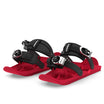
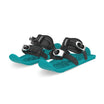












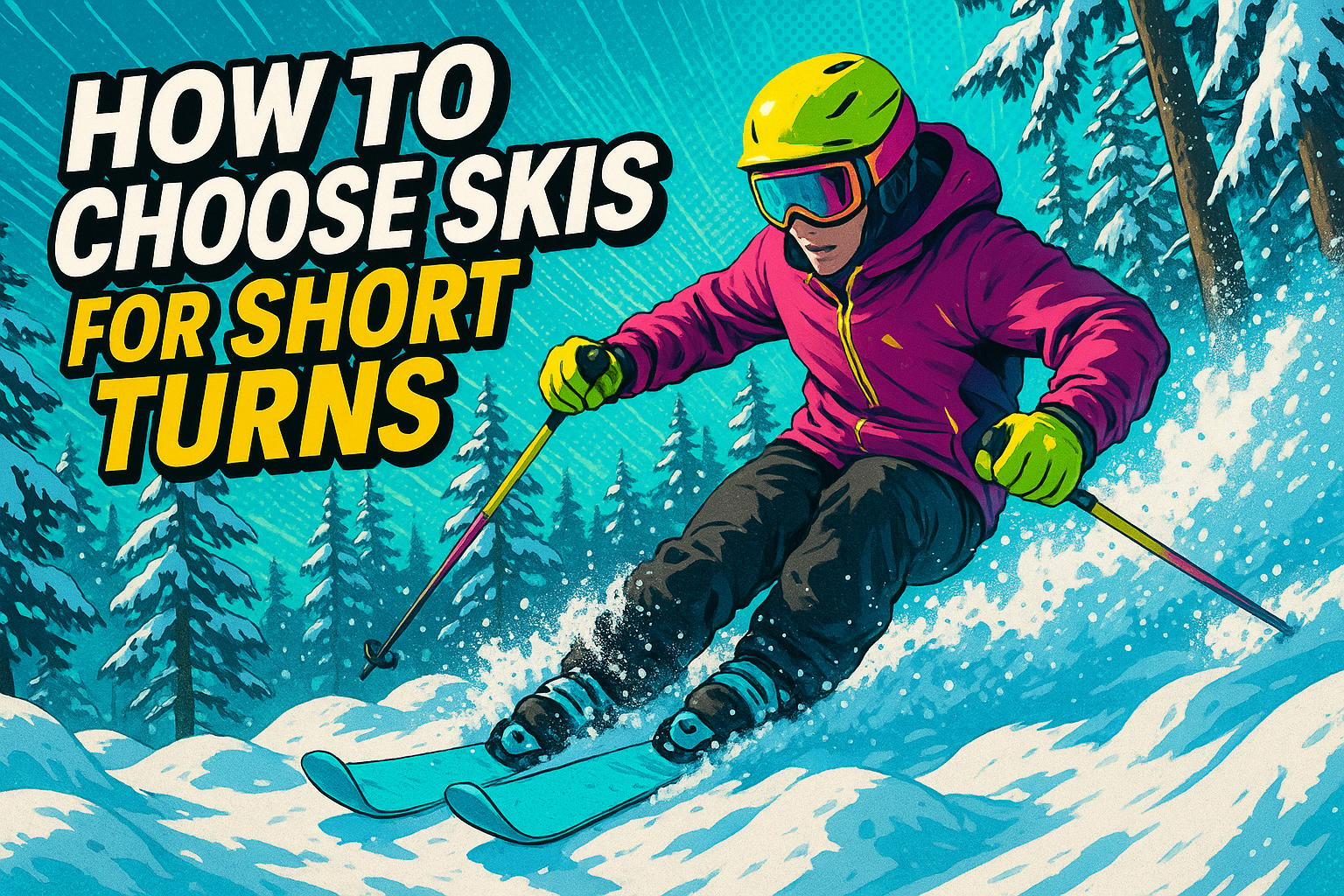




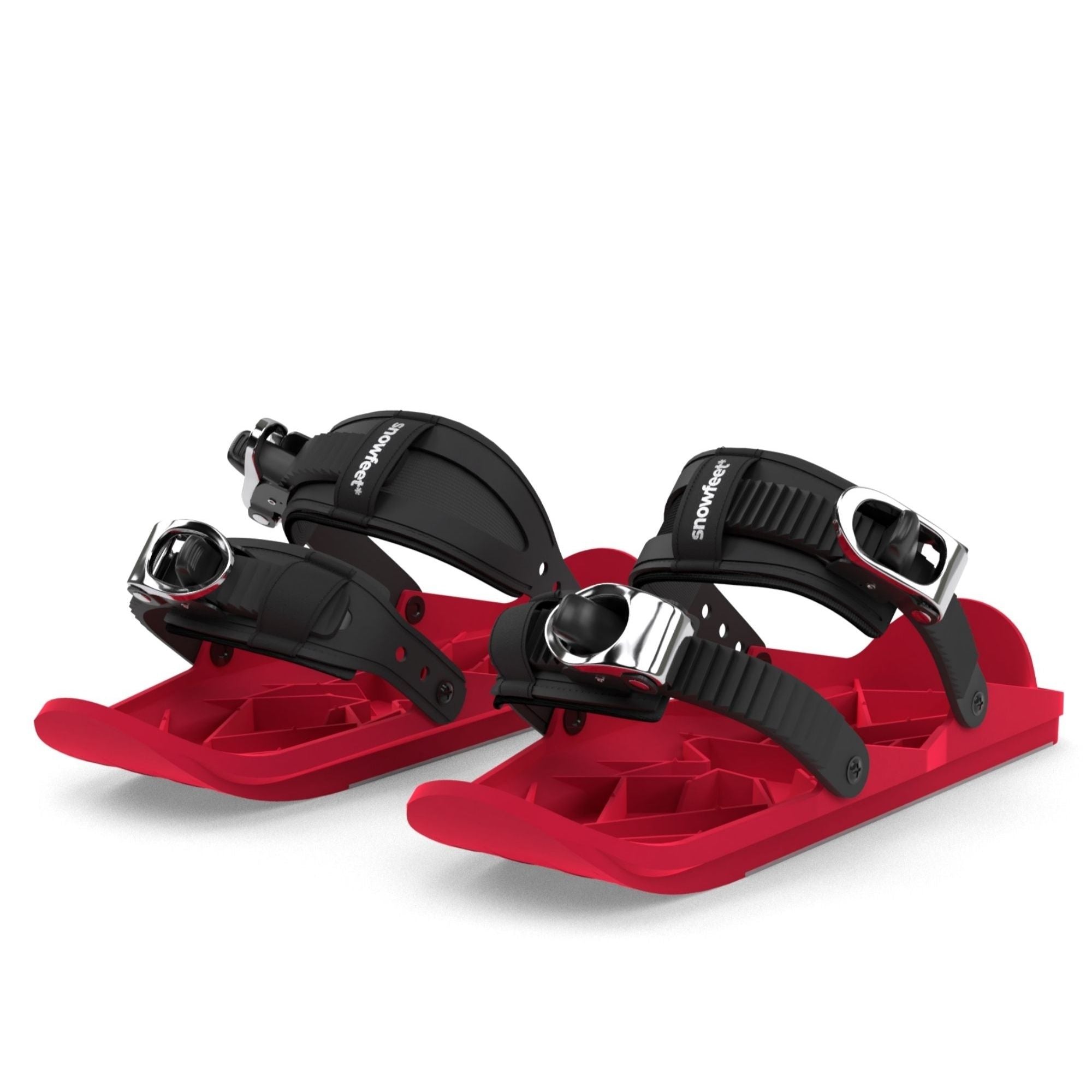
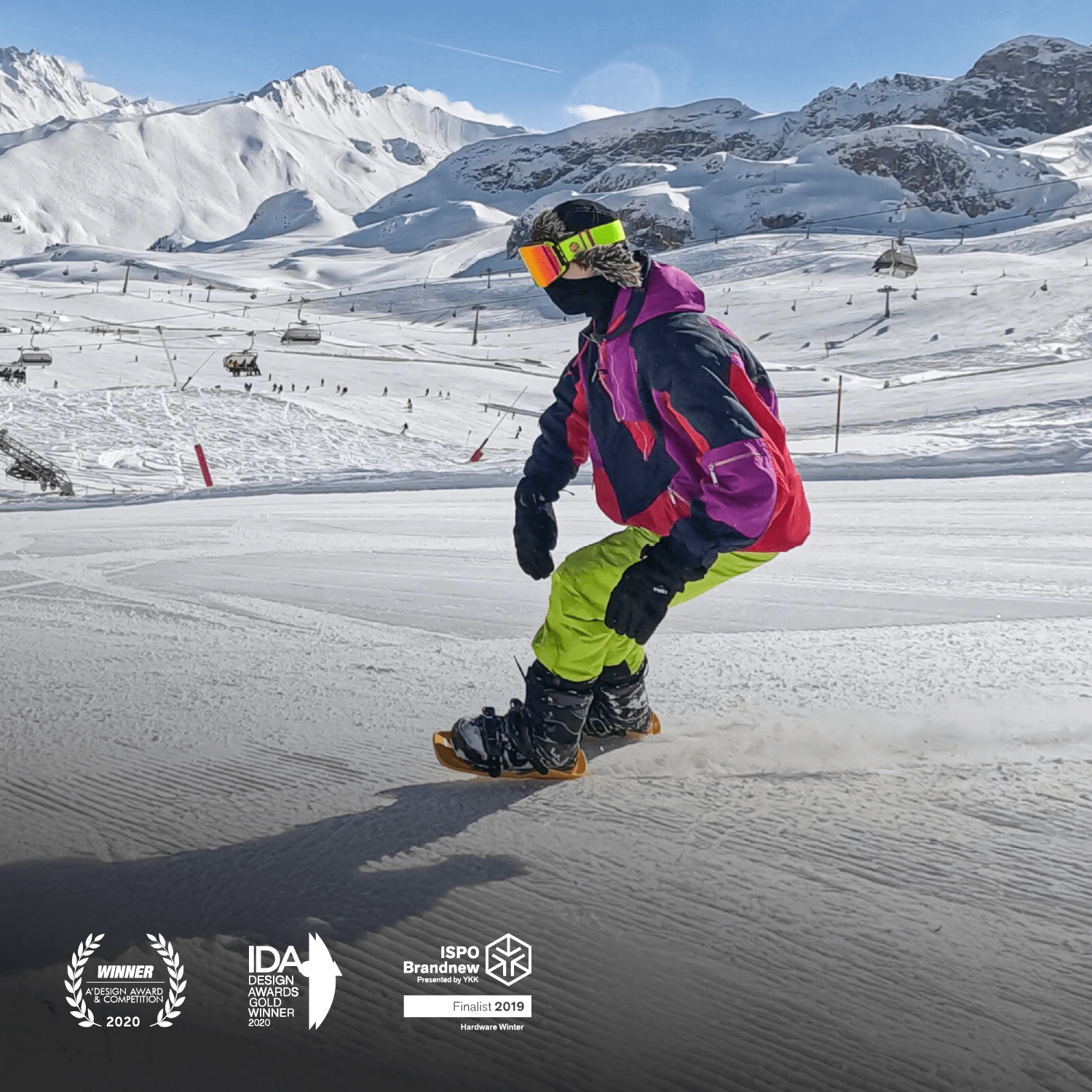




Laisser un commentaire
Ce site est protégé par hCaptcha, et la Politique de confidentialité et les Conditions de service de hCaptcha s’appliquent.